
Original Link: https://www.anandtech.com/show/1663
AMD's Sempron 3300+: 90nm Budget Computing
by Anand Lal Shimpi on April 18, 2005 2:10 AM EST- Posted in
- CPUs
When AMD offered to send us their latest Sempron CPU for review, we honestly felt a little ashamed - we had almost entirely forgotten about the budget CPU that launched last June. Had we missed other Sempron reviews since its launch? Were we too tied up in the higher end desktop processors and the dual core migration to pay attention to AMD's brand new budget line? After a moment's panic, we calmed ourselves and realized something that had surprised us a bit - AMD hadn't released a faster Socket-754 Sempron since its launch in June 2004. Not a single new CPU in ten and a half months. We stopped feeling so bad.
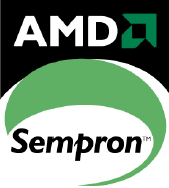
Intel was slightly better, but not by much. After our original review of the 90nm Celeron D, Intel released one more CPU, the Celeron D 345, late last year, but it's been quiet since then. And we thought the mainstream CPU race had slowed down.
So, it was time for an updated comparison, but luckily, the field hadn't changed much - or had it? Remembering back to our original Sempron review, AMD initially introduced two Semprons: a Socket-A and an Socket-754 version. The Socket-A version has topped out at 3000+ (2.0GHz) and it doesn't look like there's any future beyond it for the aging platform. The Socket-754 platform has yet to out-live its welcome and thus, AMD's newest Sempron, the Sempron 3300+, is a Socket-754-only CPU. The Socket-754 Sempron is based on AMD's K8 architecture, but is a 32-bit only CPU (no x64 support here). As a Socket-754 CPU, the Sempron only features a single channel DDR400 memory controller.
Intel's Celeron D 345 was merely a clock bump to the Celeron D 335 that we reviewed last June, bringing Intel's fastest Celeron up to 3.06GHz while still remaining on the 533MHz FSB. AMD's Sempron 3300+ isn't as simple of a transition, however. The original Socket-754 Sempron was built on a 130nm process and featured a 256KB L2 cache, whereas the new Sempron 3300+ is built on AMD's 90nm process and features a 128KB L2 cache. The new Sempron also features all of the enhancements that made it into the 90nm Athlon 64 processors - mainly SSE3 support and some enhancements to the memory controller.
The higher rating is due to a higher clock speed; the Sempron 3300+ runs at 2.0GHz compared to the 3100+'s 1.8GHz clock. But with half of the L2 cache, the performance picture is bound to be much more interesting than just a regular clock bump.
With only a 128KB L2 cache, the Sempron 3300+ is definitely a step back in terms of the cache sizes that we expect to see on modern day microprocessors. At the same time, halving the cache while moving to a smaller process ensures that AMD can enjoy larger profit margins on these new Sempron CPUs. But AMD's profit margins aren't our concern here; what we care about is how the 3300+ performs and going one step further, a cool running 90nm chip with a very small 128KB L2 cache is quite attractive to the overclocker in us.
With an on-die memory controller, the Socket-754 Semprons can get away with having relatively small L2 caches, since their main memory access latencies are very low to begin with. But even if we estimate that the on-die memory controller of a Sempron reduces memory accesses to around ~120 cycles, an access from L2 cache is going to still take about 1/10th that. In the end, while AMD's K8 architecture is less dependent on large caches, it is still not impervious to the impact that a small one can have.
Priced at $127, the Sempron 3300+ is priced similarly to Intel's Celeron D 345 ($133) and the Athlon 64 3000+ ($140). That being said, let's see how it competes...
The Test
AMD Athlon 64 Configuration
Socket-939 Athlon 64 CPUs
2 x 512MB OCZ PC3200 EL Dual Channel DIMMs 2-2-2-10
MSI nForce4 SLI Motherboard
ATI Radeon X800 XT PCI Express
AMD Sempron Configuration
Socket-754 Sempron CPUs
2 x 512MB OCZ PC3200 EL Dual Channel DIMMs 2-2-2-10
ABIT NF8 nForce3 Motherboard
ATI Radeon X800 XT AGP
Intel Celeron D Configuration
LGA-775 Intel Celeron D 345 (3.06GHz)
2 x 512MB Crucial DDR-II 533 Dual Channel DIMMs 3-3-3-12
Intel 915P Motherboard
ATI Radeon X800 XT PCI Express
Business/General Use Performance
Business Winstone 2004
Business Winstone 2004 tests the following applications in various usage scenarios:
- Microsoft Access 2002
- Microsoft Excel 2002
- Microsoft FrontPage 2002
- Microsoft Outlook 2002
- Microsoft PowerPoint 2002
- Microsoft Project 2002
- Microsoft Word 2002
- Norton AntiVirus Professional Edition 2003
- WinZip 8.1

The Sempron is a much stronger business performer than the Celeron D - that hasn't changed since we first looked at the Sempron. The 3300+ offers barely any performance improvement over the 3100+ however.
Office Productivity SYSMark 2004
SYSMark's Office Productivity suite consists of three tests, the first of which is the Communication test. The Communication test consists of the following:
"The user receives an email in Outlook 2002 that contains a collection of documents in a zip file. The user reviews his email and updates his calendar while VirusScan 7.0 scans the system. The corporate web site is viewed in Internet Explorer 6.0. Finally, Internet Explorer is used to look at samples of the web pages and documents created during the scenario."
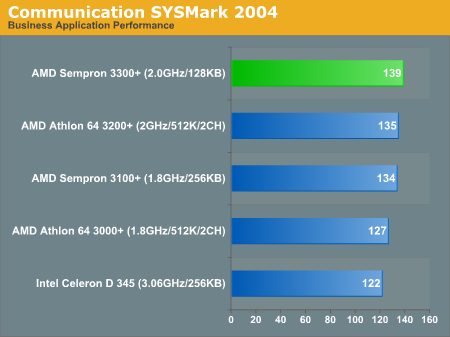
Once again, we see that the Sempron is stronger at business applications, but the 3300+ offers no real performance improvement over the 3100+.
The next test is Document Creation performance:
"The user edits the document using Word 2002. He transcribes an audio file into a document using Dragon NaturallySpeaking 6. Once the document has all the necessary pieces in place, the user changes it into a portable format for easy and secure distribution using Acrobat 5.0.5. The user creates a marketing presentation in PowerPoint 2002 and adds elements to a slide show template."

The final test in our Office Productivity suite is Data Analysis, which BAPCo describes as:
"The user opens a database using Access 2002 and runs some queries. A collection of documents are archived using WinZip 8.1. The queries' results are imported into a spreadsheet using Excel 2002 and are used to generate graphical charts."
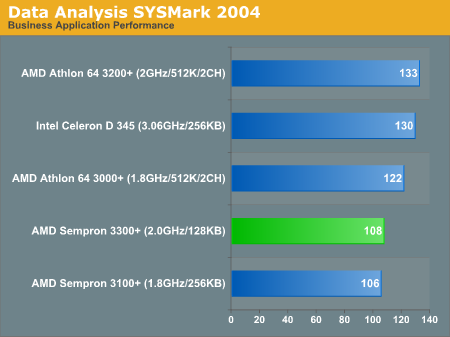
In the Data Analysis tests, the Celeron D actually outpaces the Sempron by a pretty good margin - just over 20%. The two Semprons perform identically, but it does show that the Celeron D can be quite competitive.
Mozilla 1.4
Quite possibly the most frequently used application on any desktop is the one that we pay the least amount of attention when it comes to performance. While a bit older than the core that is now used in Firefox, performance in Mozilla is worth looking at as many users are switching from IE to a much more capable browser on the PC - Firefox.

Mozilla has always favored architectures like the K8 and the Pentium M, so it is no surprise to see that the Sempron does a lot better than the Celeron D here.
ACD Systems ACDSee PowerPack 5.0
ACDSee is a popular image editing tool that is great for basic image editing options such as batch resizing, rotating, cropping and other such features that are too elementary to justify purchasing something as powerful as Photoshop. There are no extremely complex filters here, just pure batch image processing.
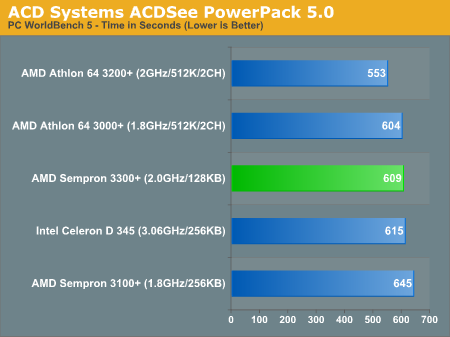
Here, the Sempron 3300+ and the Celeron D offer basically identical performance.
Multitasking Content Creation
MCC Winstone 2004
Multimedia Content Creation Winstone 2004 tests the following applications in various usage scenarios:
- Adobe® Photoshop® 7.0.1
- Adobe® Premiere® 6.50
- Macromedia® Director MX 9.0
- Macromedia® Dreamweaver MX 6.1
- Microsoft® Windows MediaTM Encoder 9 Version 9.00.00.2980
- NewTek's LightWave® 3D 7.5b
- SteinbergTM WaveLabTM 4.0f
All chips were tested with Lightwave set to spawn 4 threads.
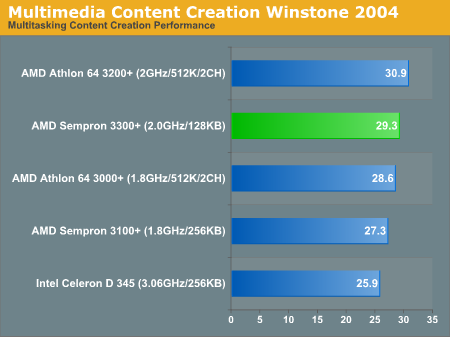
Once again, we see that in the Winstone tests, AMD's Sempron comes out on top of the Celeron D. This time around, we actually see an advantage of the 3300+ over the 3100+.
ICC SYSMark 2004
The first category that we will deal with is 3D Content Creation. The tests that make up this benchmark are described below:
"The user renders a 3D model to a bitmap using 3ds max 5.1, while preparing web pages in Dreamweaver MX. Then the user renders a 3D animation in a vector graphics format."
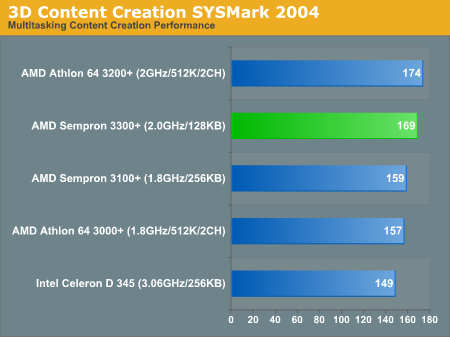
Next, we have 2D Content Creation performance:
"The user uses Premiere 6.5 to create a movie from several raw input movie cuts and sound cuts and starts exporting it. While waiting on this operation, the user imports the rendered image into Photoshop 7.01, modifies it and saves the results. Once the movie is assembled, the user edits it and creates special effects using After Effects 5.5."

The Celeron D remains reasonably competitive with the Sempron, but the 3300+ takes the 9% lead.
The Internet Content Creation suite is rounded up with a Web Publishing performance test:
"The user extracts content from an archive using WinZip 8.1. Meanwhile, he uses Flash MX to open the exported 3D vector graphics file. He modifies it by including other pictures and optimizes it for faster animation. The final movie with the special effects is then compressed using Windows Media Encoder 9 series in a format that can be broadcast over broadband Internet. The web site is given the final touches in Dreamweaver MX and the system is scanned by VirusScan 7.0."
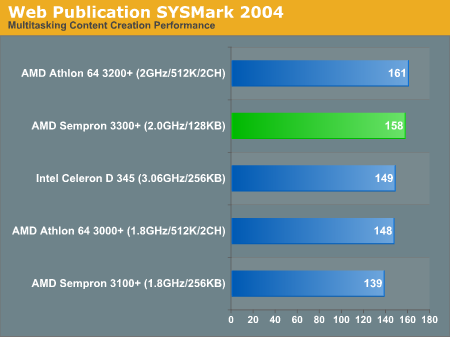
Mozilla + Media Encoder
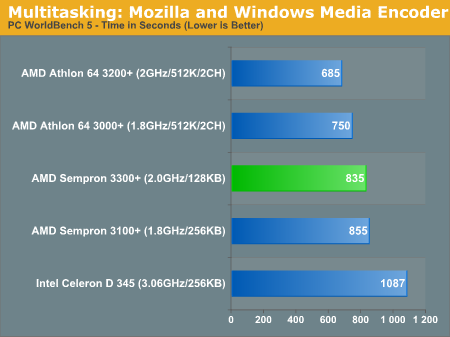
The Celeron D performed horribly in the Mozilla test, so adding Media Encoder to the mix doesn't really help anything.
Video Creation/Photo Editing
Adobe Photoshop 7.0.1
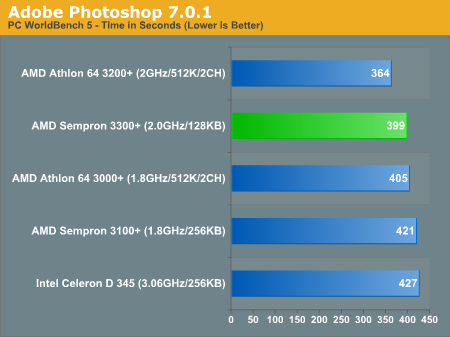
Photoshop performance is relatively similar between the contenders, with the Sempron 3300+ taking the lead.
Adobe Premier 6.5

The two Semprons perform very similarly, and both have no problem outpacing the Celeron D.
Roxio VideoWave Movie Creator 1.5
While Premier is a wonderful professional application, consumers will prefer something a little easier to use. Enter Roxio's VideoWave Movie Creator - a fairly full-featured, yet consumer level, video editing package.
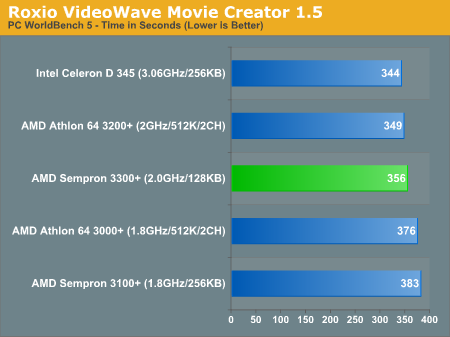
Once again, all of the contenders are fairly close in performance to one another. This time, the Celeron D takes the slight lead.
Audio/Video Encoding
MusicMatch Jukebox 7.10
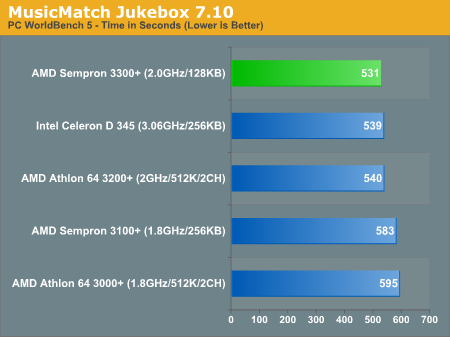
DivX 5.2.1 with AutoGK
Armed with DivX 5.2.1 and the AutoGK front end for Gordian Knot, we took all of the processors to task at encoding a chapter out of Pirates of the Caribbean. We set AutoGK to give us 75% quality of the original DVD rip and did not encode audio.

The Sempron's encoding performance is pretty competitive, but the Celeron D still pulls ahead.
XviD 5 with AutoGK
Another very popular codec is the XviD codec, and so, we measured encoding performance using it instead of DivX for this next test. The rest of the variables remained the same as the DivX test.
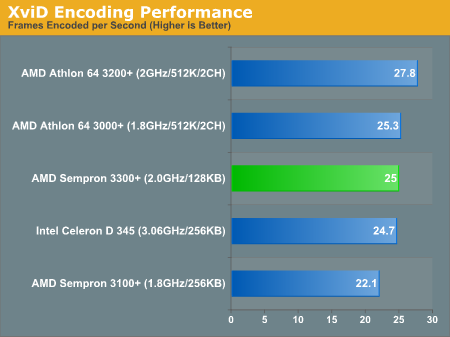
Windows Media Encoder 9
To finish up our look at Video Encoding performance, we have two tests both involving Windows Media Encoder 9. The first test is WorldBench 5's WMV9 encoding test.
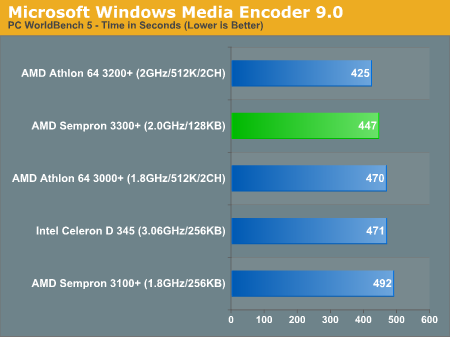
Next, we have our own home-brewed HD encoding test:
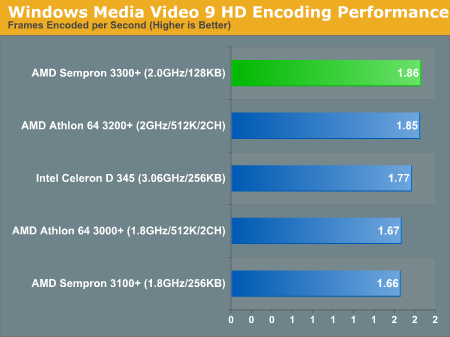
Gaming Performance
The Semprons are much stronger gaming performers than the Celeron D, showing their might in newer games like Doom 3, but the gap closes as we move to older games like UT2004 and Wolfenstein: Enemy Territory. Regardless, the Sempron is still the better gaming CPU of the two. However, there's a huge performance gap between the Semprons and the low end Athlon 64s.
Doom 3

Unreal Tournament 2004
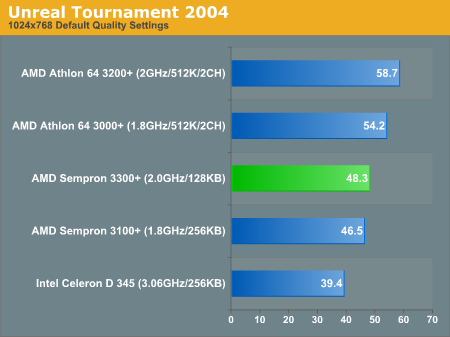
Wolfenstein: ET
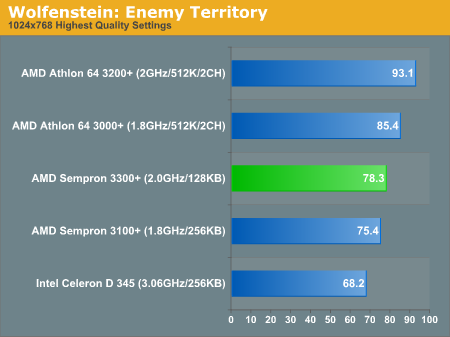
3D Rendering
3dsmax 5.1
WorldBench includes two 3dsmax benchmarks using version 5.1 of the popular 3D rendering and animation package: a DirectX and an OpenGL benchmark.
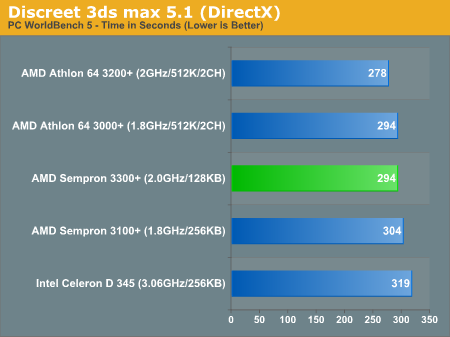
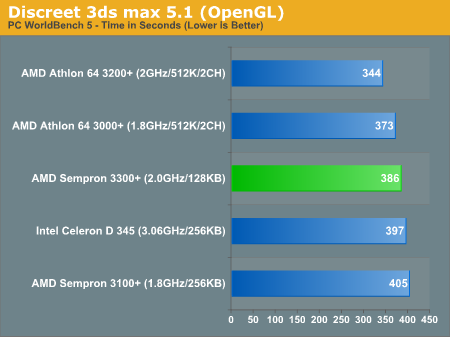
The Sempron is the faster CPU here, but once again, not by a very large margin - definitely not by the sort of margins that we're used to seeing with the Athlon 64 vs. Pentium 4 comparisons.
SPECapc - 3dsmax 6
Using the more strenuous SPECapc tests for 3dsmax, the performance gap widens and the Semprons hold a much more noticeable performance advantage over the Celeron D. Even the Sempron/Athlon 64 gap is pretty small here.
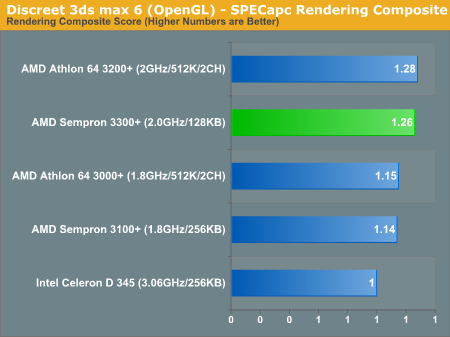
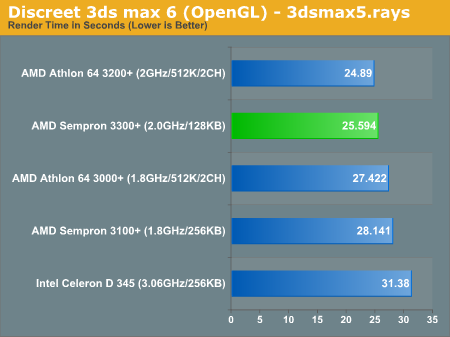
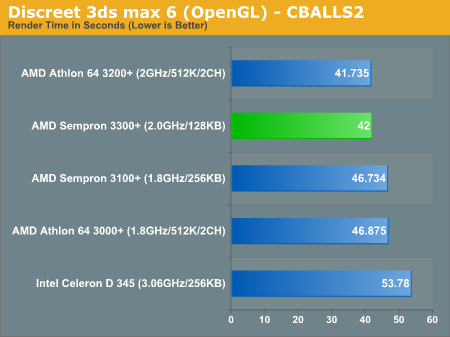
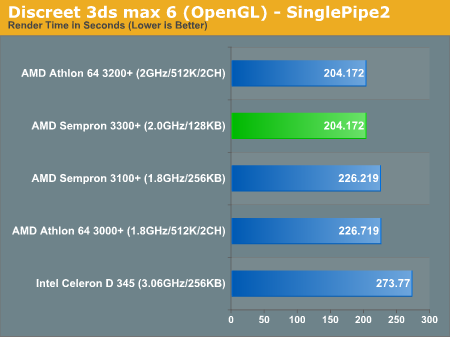
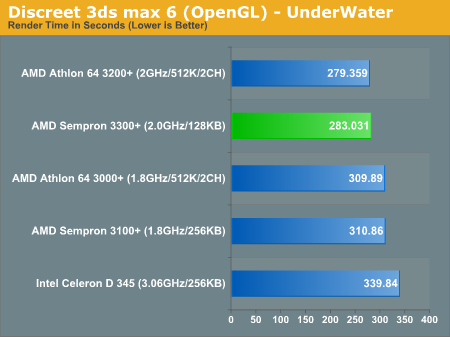
Workstation Applications
SPECviewperf 8
For our next set of professional application benchmarks, we turn to SPECviewperf 8. SPECviewperf is a collection of application traces taken from some of the most popular professional applications, and compiled together in a single set of benchmarks used to estimate performance in the various applications that the benchmark is used to model. With version 8, SPEC has significantly improved the quality of the benchmark, making it even more of a real world indicator of performance.
We have included SPEC's official description of each one of the 8 tests in the suite.
Not too surprising is the strong performance of the Sempron here; the chip's on-die memory controller ensures very good performance in all of the SPECviewperf tests.
3dsmax Viewset (3dsmax-03)
"The 3dsmax-03 viewset was created from traces of the graphics workload generated by 3ds max 3.1. To ensure a common comparison point, the OpenGL plug-in driver from Discreet was used during tracing.
The models for this viewset came from the SPECapc 3ds max 3.1 benchmark. Each model was measured with two different lighting models to reflect a range of potential 3ds max users. The high-complexity model uses five to seven positional lights as defined by the SPECapc benchmark and reflects how a high-end user would work with 3ds max. The medium-complexity lighting models use two positional lights, a more common lighting environment.
The viewset is based on a trace of the running application and includes all the state changes found during normal 3ds max operation. Immediate-mode OpenGL calls are used to transfer data to the graphics subsystem."
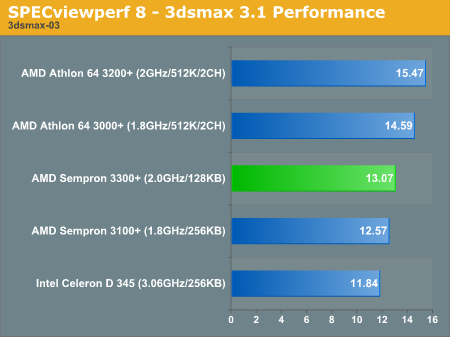
CATIA Viewset (catia-01)
"The catia-01 viewset was created from traces of the graphics workload generated by the CATIATM V5R12 application from Dassault Systems.
Three models are measured using various modes in CATIA. Phil Harris of LionHeart Solutions, developer of CATBench2003, supplied SPEC/GPC with the models used to measure the CATIA application. The models are courtesy of CATBench2003 and CATIA Community.
The car model contains more than two million points. SPECviewperf replicates the geometry represented by the smaller engine block and submarine models to increase complexity and decrease frame rates. After replication, these models contain 1.2 million vertices (engine block) and 1.8 million vertices (submarine).
State changes as made by the application are included throughout the rendering of the model, including matrix, material, light and line-stipple changes. All state changes are derived from a trace of the running application. The state changes put considerably more stress on graphics subsystems than the simple geometry dumps found in older SPECviewperf viewsets.
Mirroring the application, draw arrays are used for some tests and immediate mode used for others."
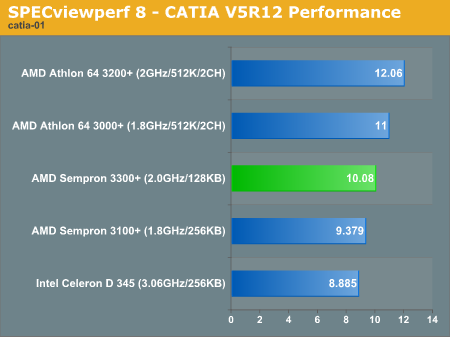
Lightscape Viewset (light-07)
"The light-07 viewset was created from traces of the graphics workload generated by the Lightscape Visualization System from Discreet Logic. Lightscape combines proprietary radiosity algorithms with a physically based lighting interface.
The most significant feature of Lightscape is its ability to simulate global illumination effects accurately by precalculating the diffuse energy distribution in an environment and storing the lighting distribution as part of the 3D model. The resulting lighting "mesh" can then be rapidly displayed."
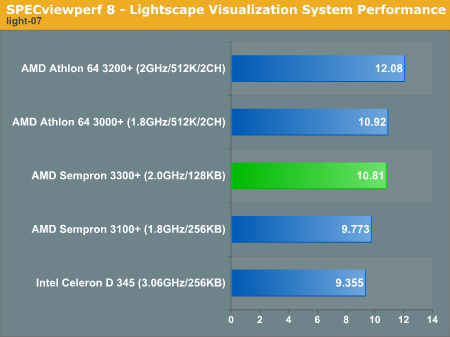
Maya Viewset (maya-01)
"The maya-01 viewset was created from traces of the graphics workload generated by the Maya V5 application from Alias.
The models used in the tests were contributed by artists at NVIDIA. Various modes in the Maya application are measured.
State changes as made by the application are included throughout the rendering of the model, including matrix, material, light and line-stipple changes. All state changes are derived from a trace of the running application. The state changes put considerably more stress on graphics subsystems than the simple geometry dumps found in older viewsets.
As in the Maya V5 application, array element is used to transfer data through the OpenGL API."
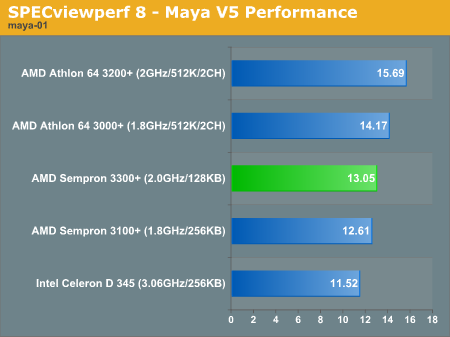
Pro/ENGINEER (proe-03)
"The proe-03 viewset was created from traces of the graphics workload generated by the Pro/ENGINEER 2001TM application from PTC.
Two models and three rendering modes are measured during the test. PTC contributed the models to SPEC for use in measurement of the Pro/ENGINEER application. The first of the models, the PTC World Car, represents a large-model workload composed of 3.9 to 5.9 million vertices. This model is measured in shaded, hidden-line removal, and wireframe modes. The wireframe workloads are measured both in normal and antialiased mode. The second model is a copier. It is a medium-sized model made up of 485,000 to 1.6 million vertices. Shaded and hidden-line-removal modes were measured for this model.
This viewset includes state changes as made by the application throughout the rendering of the model, including matrix, material, light and line-stipple changes. The PTC World Car shaded frames include more than 100MB of state and vertex information per frame. All state changes are derived from a trace of the running application. The state changes put considerably more stress on graphics subsystems than the simple geometry dumps found in older viewsets.
Mirroring the application, draw arrays are used for the shaded tests and immediate mode is used for the wireframe. The gradient background used by the Pro/E application is also included to better model the application workload."
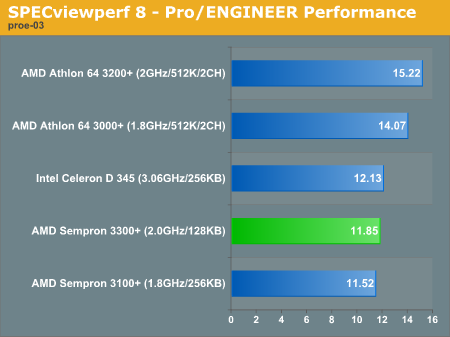
SolidWorks Viewset (sw-01)
"The sw-01 viewset was created from traces of the graphics workload generated by the Solidworks 2004 application from Dassault Systemes.
The model and workloads used were contributed by Solidworks as part of the SPECapc for SolidWorks 2004 benchmark.
State changes as made by the application are included throughout the rendering of the model, including matrix, material, light and line-stipple changes. All state changes are derived from a trace of the running application. The state changes put considerably more stress on graphics subsystems than the simple geometry dumps found in older viewsets.
Mirroring the application, draw arrays are used for some tests and immediate mode used for others."

Unigraphics (ugs-04)
"The ugs-04 viewset was created from traces of the graphics workload generated by Unigraphics V17.
The engine model used was taken from the SPECapc for Unigraphics V17 application benchmark. Three rendering modes are measured -- shaded, shaded with transparency, and wireframe. The wireframe workloads are measured both in normal and anti-alised mode. All tests are repeated twice, rotating once in the center of the screen and then moving about the frame to measure clipping performance.
The viewset is based on a trace of the running application and includes all the state changes found during normal Unigraphics operation. As with the application, OpenGL display lists are used to transfer data to the graphics subsystem. Thousands of display lists of varying sizes go into generating each frame of the model.
To increase model size and complexity, SPECviewperf 8.0 replicates the model two times more than the previous ugs-03 test."
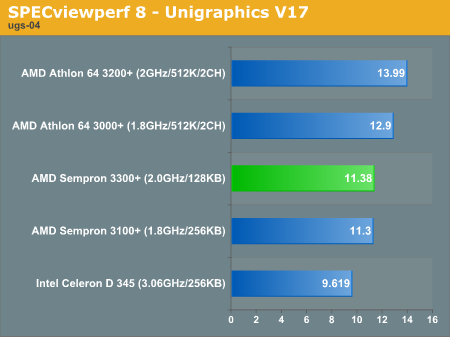
Overclocking & Final Words
As a general use CPU for office applications and your normal day-to-day tasks, the Sempron is quite strong and definitely faster than its Celeron D counterpart. However, applications for the power user, workstation user or the gamer suffer greatly because of its single channel memory controller and small L2 cache. But given that the new Sempron is built on AMD's cooler 90nm process, we decided to see how far the new chip would overclock.
The Sempron 3300+ has a default core voltage of 1.400V. Bumping it to 1.500V and increasing the FSB to 240MHz yielded us a nice and even 2.4GHz, a 20% increase in clock frequency. But the real question is, how much of a performance boost will the added clock speed bring you?
While we didn't run a full suite of tests, we picked a handful of our benchmarks on which to focus in order to get a good idea of whether or not overclocking will make Sempron any more desirable. The end result was basically this:
- In applications where the Sempron was already quite competitive with similarly clocked Athlon 64s, the overclocked Sempron did extremely well, as you would expect.
- In those applications, particularly games, where the Sempron didn't do so well, overclocking did nothing to help. For example, despite a 20% increase in clock speed, Doom 3 performance only went up by around 4% when we overclocked the Sempron 3300+.
Our overclocking findings helped create a general recommendation for the Sempron; for those users who are most likely to want to overclock to increase performance, the Sempron (despite its wonderful overclockability) isn't the chip for you. Gamers will find that similarly priced Athlon 64s are much better performers, especially if you are able to use the Socket-939 platform.
If you're debating between a Sempron 3100+ and a 3300+, the two often times perform identically to one another. Some applications will favor the Sempron 3100+'s larger L2 cache, while others will favor the higher clock speed of the 3300+. We generally prefer the 3300+, thanks to its cooler running 90nm process, but the two do perform very similarly and are hard to tell apart in real world usage.
Compared to Intel's Celeron D, the Sempron continues to be the better buy and overall, the better performer. According to Intel's roadmaps, a 3.2GHz Celeron D is due out soon, but until then, the Sempron manages to hang on to the budget CPU throne.







